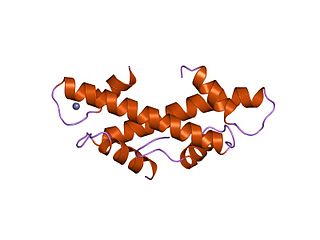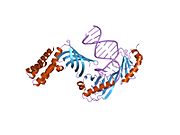
The TATA-binding protein (TBP) is a general transcription factor that binds specifically to a DNA sequence called the TATA box. This DNA sequence is found about 30 base pairs upstream of the transcription start site in some eukaryotic gene promoters.
Transcription factor TFIIA is a nuclear protein involved in the RNA polymerase II-dependent transcription of DNA. TFIIA is one of several general (basal) transcription factors (GTFs) that are required for all transcription events that use RNA polymerase II. Other GTFs include TFIID, a complex composed of the TATA binding protein TBP and TBP-associated factors (TAFs), as well as the factors TFIIB, TFIIE, TFIIF, and TFIIH. Together, these factors are responsible for promoter recognition and the formation of a transcription preinitiation complex (PIC) capable of initiating RNA synthesis from a DNA template.

Transcription initiation factor TFIID subunit 6 is a protein that in humans is encoded by the TAF6 gene.

Transcription initiation factor TFIID subunit 7 also known as TAFII55 is a protein that in humans is encoded by the TAF7 gene.

Transcription initiation factor TFIID subunit 1, also known as transcription initiation factor TFIID 250 kDa subunit (TAFII-250) or TBP-associated factor 250 kDa (p250), is a protein that in humans is encoded by the TAF1 gene.

TAF9 RNA polymerase II, TATA box binding protein (TBP)-associated factor, 32kDa, also known as TAF9, is a protein that in humans is encoded by the TAF9 gene.

Transcription initiation factor TFIID subunit 12 is a protein that in humans is encoded by the TAF12 gene.

Transcription initiation factor TFIID subunit 4 is a protein that in humans is encoded by the TAF4 gene.

Transcription initiation factor TFIID subunit 2 is a protein that in humans is encoded by the TAF2 gene.

Transcription initiation factor TFIID subunit 10 is a protein that in humans is encoded by the TAF10 gene.

Transcription initiation factor TFIID subunit 5 is a protein that in humans is encoded by the TAF5 gene.

Transcription initiation factor TFIID subunit 11 also known as TAFII28, is a protein that in humans is encoded by the TAF11 gene.

TATA-binding protein-associated factor 2N is a protein that in humans is encoded by the TAF15 gene.

Dr1-associated corepressor is a protein that in humans is encoded by the DRAP1 gene.

Protein Dr1 is a protein that in humans is encoded by the DR1 gene.

TATA-binding protein-associated factor 172 is a protein that in humans is encoded by the BTAF1 gene.

Transcription initiation factor TFIID subunit 13 is a protein that in humans is encoded by the TAF13 gene.

Transcription initiation factor TFIID subunit 8 is a protein that in humans is encoded by the TAF8 gene.

TATA box-binding protein-like protein 1 is a protein that in humans is encoded by the TBPL1 gene.

The TBP-associated factors (TAF) are proteins that associate with the TATA-binding protein in transcription initiation. It is a part of the transcription initiation factor TFIID multimeric protein complex. It also makes up many other factors, including SL1. They mediate the formation of the transcription preinitiation complex, a step preceding transcription of DNA to RNA by RNA polymerase II.
























